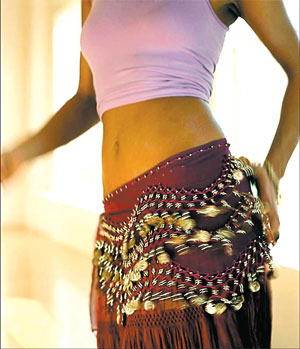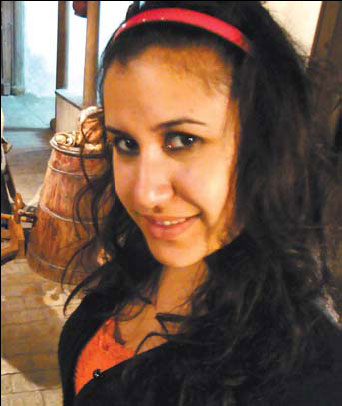Hooked on the hippest craze
The tip of Fatma Sule Sahin's toe gently brushes the floor as she performs one of the oldest dances in history. The darbuka drum creates an unmistakable aura of Middle Eastern mysticism as the 22-year-old sways sensuously to the rhythm of the music. Her fluid movements are beautifully alluring and enchanting.
Turkish belly dancing has always been popular internationally. Latino superstar Shakira and Hollywood celebrity Paris Hilton are among the many fans enamored of this dance, which originated in the rakkase - Turkish dancing girls who performed at the height of the Ottoman Empire.
|
Belly dancing, a trend imported from the Middle East, is now developing in major Chinese cities. Quanjing |
Sahin is a native of Izmir, Turkey. She gives free belly dancing classes at Beijing Union University. Proud to say she is the dance instructress of the Antalya belly dance troupe, Sahin taught in Turkey for three years, where she also toured as a dancer. But, she says she is happier teaching than dancing.
The Chinese language student has lived in Beijing for nine months and was soon captivated by local dancing traditions. She joined the locals in their morning and afternoon dance sessions, and performed with Chinese dancers at Beijing University stadium. She has already learnt six different forms of Chinese dance.
As Sahin is still learning Chinese and sometimes find communication difficult, she bypasses the linguistic barrier through the language of dance. Not restricted to Turkish belly dancing, she is also adept at hip-hop and contemporary dance.
"I often go to parks where Chinese people dance in public and mingle and dance along with them. They have taught me different forms of Chinese dancing."
But Sahin was surprised to discover most foreigners are unaware there exists a distinct genre of Turkish belly dance. They seem to think there is only one style and it originated in Arabic countries. Many people see belly dancing as just another element of the 1001 Arabian Nights, according to Sahin.
The Turkish belly dance is strongly embedded in Turkish culture. It is performed at weddings, birthday celebrations and at gatherings of family and friends. The style evolved from the Turkish folk ciftetelli dance - a slow, languid dance with snake-like arm gestures and sensuous floor movements.
"The two better-known forms of Turkish belly dancing are the belly dance itself, and what we commonly call the Oriental dance, which is the one that is geared to public performances," she says.
The Oriental dance is called Oryantal dans in Turkish. It is a form of belly dancing that is a fusion of Turkish, Arabic, Egyptian and Indian influences.
The Turkish Oriental dance, however, has developed its own distinct flavor. Turkish dancers wear more revealing clothes and are more expressive in their movements. They also use zils or finger cymbals, to create extra rhythm.
"When people hear about belly dancing, they instantly think of the Oriental dance. Many can't distinguish between it and any other."
"I teach the traditional Turkish dance and not the Oriental dance. It is a lot more personal because you can dance any time and without a specified costume," she says.

A knowledge of music is vital to Turkish belly dancing, she says, as a dancer must be familiar with classical music as well as spirited contemporary songs.
Ismail Cagan Dilemre, a lute player from Canakkale, Turkey, is an expert in this field. Drawing on 13 years of experience, he has performed professionally with famous Turkish poets and musicians, such as Avni Anil, Aydin Tekindor and Nurettin Portakal.
"Today's classical Arab music and the Ottoman classical music have a broader repertoire. They utilize a wider range of makam (a system of melodic modes) and a variety of usul (rhythmic modes). Turkish belly dance music has its own sounds, specifically deriving from Ottoman classical music," Dilemre says.
"It is mostly about love and emotions. The belly dance attempts to visually communicate these feelings and emotions even with the simplest of movements," he adds.
All Turkish expats will proudly tell you about their belly dancing tradition. Ozge Nur Kiziloluk, a 22 year-old language student from Ankara, says most Turkish girls know how to belly dance.
"Belly dancing to a Turkish girl is like doing calligraphy to a Chinese. We learn to belly dance from the moment we were born, because we live in that culture. When we go to a wedding ceremony, every summer, every spring, we dance. It's part of being Turkish."
|
Turkish Fatma Sule Sahin is captivated by Chinese dancing traditions as she introduces Turkey's belly dancing to Chinese people. Dania Karina |
Along with other Turkish students, Sahin had initially come to Beijing to learn Mandarin. Driven by her ambition to try her hands in trading between Turkey and China, she feels that Mandarin has become a crucial language to know.
Coming from a different culture does not pose any problem for Sahin, who enjoys the experience of studying abroad and who travels around China whenever she gets the chance. Understanding her fellow Turkish homesickness however, she admits Beijing could use more authentic Turkish establishments.
"We come from a beautiful country, rich in culture and traditions, and we have our own ways of doing things different from the Chinese. I only know of two authentic Turkish restaurants here, I think they're not enough," she laughs.
"I know more than 50 Turkish people in China, but it is not easy to connect with them. There is no place for us to meet up and just be Turks."
Sahin says she began dancing professionally for relaxation and to keep in shape. "But I have danced ever since I was very young, and I am of Arabic descent. So if you ask me about belly dancing, it's in my blood," she says with a smile.
"Music and dancing are an integral part of me naturally. I am looking forward to sharing my knowledge about Turkish belly dancing with more people in China, as well as to introducing more of Turkey's culture to anyone who is willing to learn."
(China Daily 06/13/2008 page19)
















